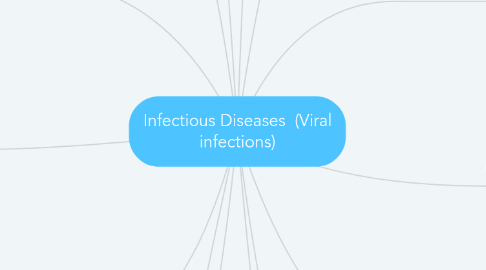
1. Primary herpetic gingivostomatitis
1.1. Etiology
1.1.1. Herpes simplex virus, most are type 1 some are type 2
1.2. Description
1.2.1. multiple tiny vesicles that form painful ulcers that are red, and painful. It occurs in the lips, gingival and oral mucosa, generally found in children.
1.3. Diagnosis
1.3.1. Clinical, Microscopic
1.4. Prognosis
1.4.1. Good
1.5. Treatment
1.5.1. None, lesions heal on their own in 1-2 weeks spontaneously.
2. Recurrent herpes simplex infection
2.1. Etiology
2.1.1. Herpes simplex virus
2.2. Description
2.2.1. Tiny vesicles that merge together to form a single ulcer, found on vermillion of lips, hard pate and gingiva of adolescents and adults
2.3. Diagnosis
2.3.1. Clinical
2.4. Prognosis
2.4.1. Good
2.5. Treatment
2.5.1. antiviral drugs such as acyclovir but not for intraoral lesions. No treatment may be given
3. Herpes zoster
3.1. Etiology
3.1.1. Varicella-zoster virus
3.2. Description
3.2.1. painful vesicles on one side of body along a sensory nerve
3.3. Diagnosis
3.3.1. Clinical
3.4. Prognosis
3.4.1. Good
3.5. Treatment
3.5.1. Antiviral agents, corticosteroids
4. Herpangina
4.1. Etiology
4.1.1. A coxsackievirus
4.2. Description
4.2.1. Vesicles on soft palate and tonsillar area, fever, mild headache. Occurs in children
4.3. Diagnosis
4.3.1. Clinical
4.4. Prognosis
4.4.1. Good
4.5. Treatment
4.5.1. None, usually resolves in less than 1 week
5. Acute lymphonodular pharyngitis
5.1. Etiology
5.1.1. A coxsackievirus
5.2. Description
5.2.1. Oral lesions in the soft palate and tonsillar area, accompanied by fever, mild headache and sore throat in children
5.3. Diagnosis
5.3.1. Clinical
5.4. Prognosis
5.4.1. Good
5.5. Treatment
5.5.1. None, usually lasts several days to 2 weeks
6. Mumps
6.1. Etiology
6.1.1. A paramyxovirus
6.2. Description
6.2.1. Painful,bilateral enlargement of salivary glands most commonly occurs in children
6.3. Diagnosis
6.3.1. Clinical
6.4. Prognosis
6.4.1. Good
6.5. Treatment
6.5.1. None, it heals spontaneously
7. HIV/AIDS
7.1. Etiology
7.1.1. Immune deficiency from infection of human immunodeficiency virus
7.2. Description
7.2.1. oral candiadiasis, hairy leukoplakia, papillomavirus lesions, kaposi sarcoma, lymphoma, major aphthouslike ulcers, xerostemia, etc. may occur in newborns to adults
7.3. Diagnosis
7.3.1. Laboratory, Microscopic
7.4. Prognosis
7.4.1. Good
7.5. Treatment
7.5.1. Combination of antiretroviral agents, and management of specific opportunistic disease
8. Verruca vulgaris
8.1. Etiology
8.1.1. A human papillovirus, most commonly HPV type 2
8.2. Description
8.2.1. white, papillary, exophytic lesion resembling a papilloma usually found in the lips, but can also be found on the skin of children and adults
8.3. Diagnosis
8.3.1. Microscopic
8.4. Prognosis
8.4.1. Good
8.5. Treatment
8.5.1. Surgical excision, immunologic staining to identify presence of papillomavirus
9. Condyloma acuminatum
9.1. Etiology
9.1.1. A human Papillovirus usually HPV type 6 and 11
9.2. Description
9.2.1. Pink, papillary lesion that is usually more diffused than verruca vulgaris, Found in the oral mucosa of adults
9.3. Diagnosis
9.3.1. Microscopic
9.4. Prognosis
9.4.1. Good
9.5. Treatment
9.5.1. Surgical excision, recurrence is common
10. Multifocal epithelial hyperplasia
10.1. Etiology
10.1.1. HPV type 13 and 32
10.2. Description
10.2.1. Multiple white to pale pink nodules that are distributed throughout the oral mucosa in children
10.3. Diagnosis
10.3.1. Clinical, Microscopic
10.4. Prognosis
10.4.1. Good
10.5. Treatment
10.5.1. Does not require treatment, lesions heal spontaneously weeks to months
11. Chickenpox
11.1. Etiology
11.1.1. Varicella-zoster virus
11.2. Description
11.2.1. vesicular and pustular eruptions usually in the skin of children, less common in adolescents and adults
11.3. Diagnosis
11.3.1. Clinical
11.4. Prognosis
11.4.1. Good
11.5. Treatment
11.5.1. None, it heals in 2-3 weeks
12. Infectious mononucleosis
12.1. Etiology
12.1.1. Epstein-Barr virus
12.2. Description
12.2.1. Palatal petechiae, sore throat, fever, malaise, fatigue, enlarged spleen, and generalized lymphadenopathy usually in young children and adults
12.3. Diagnosis
12.3.1. Laboratory
12.4. Prognosis
12.4.1. Good
12.5. Treatment
12.5.1. None, usually heals by itself in 4-6 weeks
13. Hand-foot-and-mouth disease
13.1. Etiology
13.1.1. A coxsackievirus
13.2. Description
13.2.1. Vesicles anywhere in the mouth, can also occur in the feet, hands and fingers of children under 5
13.3. Diagnosis
13.3.1. Cllinical
13.4. Prognosis
13.4.1. Good
13.5. Treatment
13.5.1. None. Lesions resolve in 2 weeks
14. Measles
14.1. Etiology
14.1.1. A paramyxovirus
14.2. Description
14.2.1. koplik spots,red macules with white necrotic centers most commonly in children
14.3. Diagnosis
14.3.1. Clinical
14.4. Prognosis
14.4.1. Good
14.5. Treatment
14.5.1. None, it heals spontaneously

